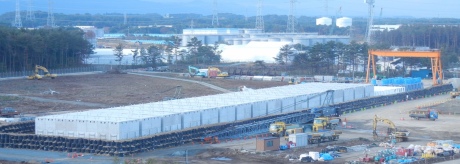Treatment of Fukushima Daiichi's huge inventories of radioactive water is being provided by a range of private companies in an operation of unprecendented scale, which is increasing still further. Over 250,000 cubic metres of water have been processed so far, reducing original radioactivity by 88%.
Efforts to bring the overheating reactor units of Fukushima Daiichi back under control last year involved the injection of water directly from the sea, containing a range of substances as well as salt. This water flowed across the molten reactor cores and picked up a range of radionuclides before emerging from the damaged reactor vessels to accumulate in the building basements. The result was an enormous and increasing inventory of polluted and highly radioactive water that represented a major hazard in itself.
Unable to prevent the water from leaking out of the reactor vessels, Tokyo Electric Power Company (Tepco) reduced the amounts in the basements by pumping to on-site waste management facilities and then establishing a system to decontaminate the water so that it could be re-injected, using the basements as a part of a closed cooling loop. Two separate leaks of the water to sea were plugged and the company changed from the intial ad-hoc fire hose injection to use of the reactor systems' normal robust feedwater and core spray systems.
 |
| Caesium that was once trapped in the reactor cores has passed into coolant water and is then concentrated in ion-exchange absorption towers that are stored on-site |
Key to the operation was the involvement of the private companies that worked with Tepco to set up an array of clean-up systems to separate oil, then decontaminate and desalinate the basement water ready for re-injection.
The decontamination step represents a joint effort of four firms, working for Tepco: Kurion, Areva Toshiba and Shaw. Removing the principal hazard, caesium-137, is a first-stage absorption system from Kurion, backed up by a decontamination system from Areva. A second caesium absorption set-up called SARRY (simplified active water retrieval and recovery system) then comes into play, provided by Toshiba and Shaw and using Honeywell ion-exchange materials. There is a certain amount of redundancy between the systems, which enables water processing to continue unaffected by any minor breakdowns or servicing requirements.
Kurion claimed that the overall system has processed more than 258,000 cubic metres of water since start-up on 17 June, removing about 88% of the initial radioactive inventory. The company estimated that amount as 27 times the radioactivity removed from liquid treated each year from normal operation of the USA's 104 nuclear power reactors.
Used ion-exchange towers from the decontamination plant go to a newly built storage area, while decontaminated water amounting to 1200 tonnes each day goes to buffer tanks on site, ready for desalination. The desalination plant can produce 480 cubic metres of of fresh water each day, while 720 cubic metres of condensed salt water goes to storage. Salinity of the water is now down to 10% of what it was before the system started up.
Tepco has made a commitment to the Japanese government to improve the decontamination process still further and has contracted Toshiba to bring in another stage, which will use technology from Energy Solutions known as the Advanced Liquid Processing System. The two companies will now begin to design and install the extra system, to remove further radionuclides present at very low concentrations in the decontaminated water. Fortum of Finland will be supplying granular ion-exchange media to Energy Solutions for the new plant, specialised in removing caesium and strontium.
Researched and written
by World Nuclear News




_18570.jpg)
_18938.jpg)
_33584.jpg)
_82983.jpg)





